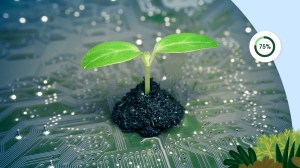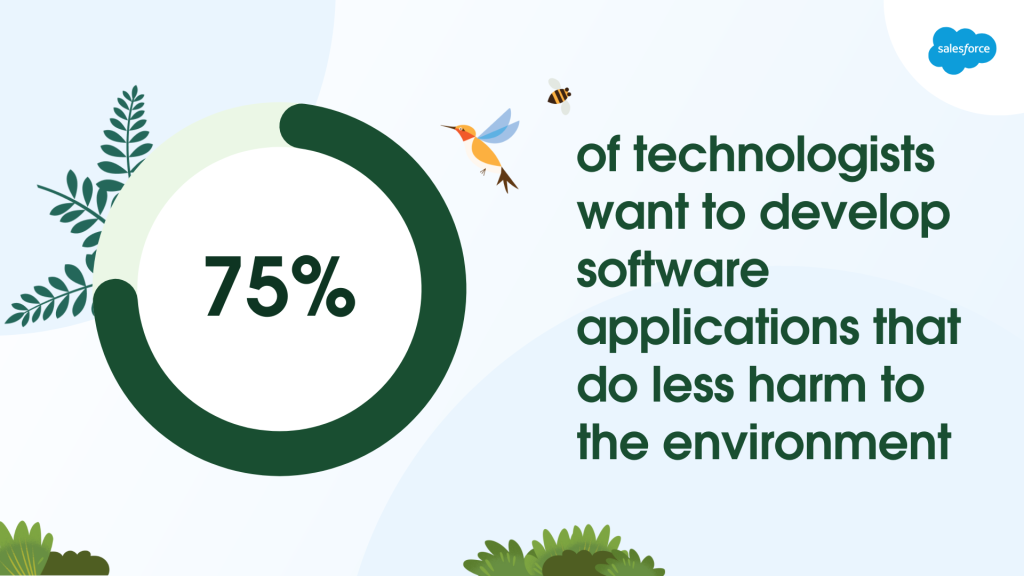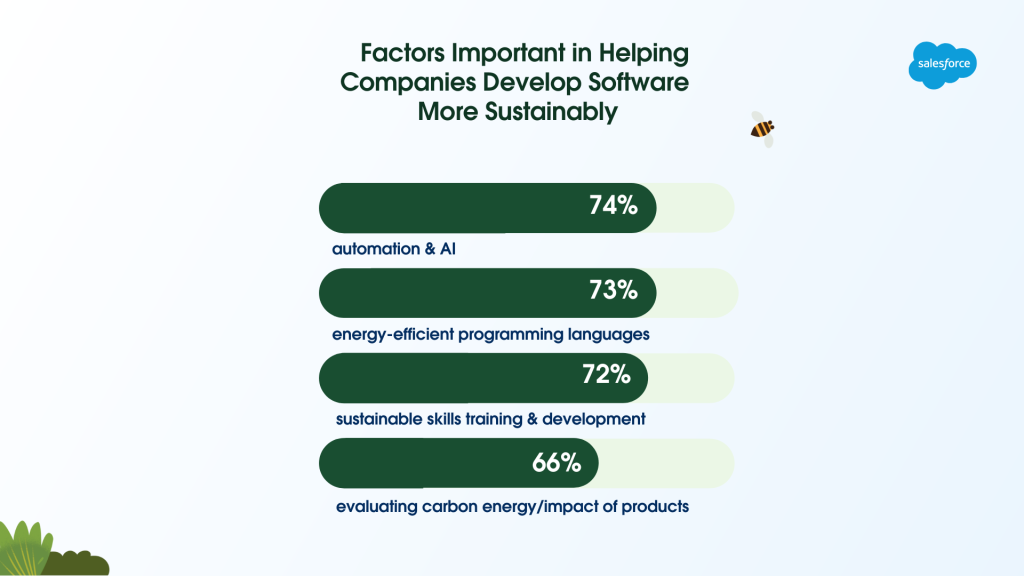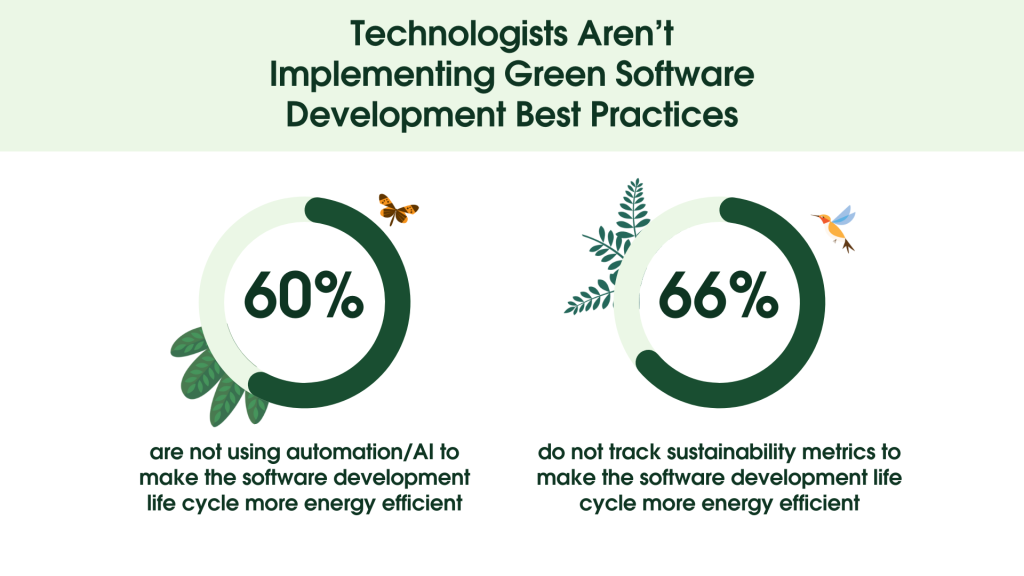Information and communication tech is expected to account for 14% of the world’s carbon footprint by 2040
75% of technologists want to develop software applications that do less harm to the environment
However, 76% also say their leadership doesn’t see sustainable software development as a must-have
Insights from a new Salesforce survey of over 1,000 U.S., U.K., and Australia-based technologists — including UX designers, software developers, system architects, IT operations managers, and more — show that while 75% are eager to help reduce their environmental impact, green coding and sustainability aren’t yet practiced at their job.
The survey, titled The Green Code Gap, reveals why: a gap in skills or knowledge and lack of sustainability prioritization by their employers.
Technologists seek to mitigate their environmental impact
When it comes to concern about the environment, it’s not all about supply chains and transportation. The energy consumption of Information and Communication Technologies (ICT), technologies and tools used to communicate, store, retrieve, and manage information, is increasing by 9% every year. By 2040, ICT is expected to account for 14% of the world’s carbon footprint — up from about 1.5% in 2007.
The Green Code Gap research shows that technologists are eager to do something about it.
From writing code to tracking environmental impact, teams also recognize the importance of implementing best practices to help their company develop more sustainable products.
Green software development remains scarce as IT emissions rise
While technologists want to act, they report little knowledge or training around sustainable development at their job. In fact, lack of insight into how to develop sustainable software is cited as the top barrier to doing so among this audience. And, nearly half (45%) of technologists surveyed confess they don’t know how to develop software applications that do less harm to the environment.
As a result, over one-third (34%) of technologists rarely or never consider carbon emissions when doing their job. In fact, over 4 in 10 technologists do not reuse existing code for most projects. That’s a problem, because developing new lines of code requires energy, and, unless an organization’s efforts are powered by 100% renewable energy, using additional energy increases carbon emissions. Writing code from scratch also results in additional time and resources (e.g. developer hours), which also contribute to carbon emissions. And, over half are not using energy-efficient programming languages (e.g, C, C++, Java), which are proficient at optimizing software to minimize resource consumption while executing code.
Energy-efficient programming and reusable code aren’t the only green software development practices technologists are missing in their work. They aren’t leveraging technology like automation, AI, or tracking sustainability metrics to lessen their work’s harm on the environment, either.
Technologists wrestle with leadership’s stance on sustainability
The survey reveals that while many technologists would like to lessen their environmental impact, they don’t believe their leadership is aligned. Nearly half (45%) of technologists believe they are more worried about environmental impacts of their company’s software than their leadership is. And while a similar number (44%) believe sustainable software development is a must-have, 76% say their leadership do not.
This also extends to their workplace:
- About one-third (31%) of technologists say sustainable software development is not openly discussed at their company.
- Most (62%) technologists do not participate in sustainability-related skills training and development at their company.
The misalignment around sustainability may get worse as companies race to integrate emerging technologies like generative AI into their tech stack.
Training popular generative AI tools such as Large Language Models (LLMs) takes a massive amount of computational power. And anything that requires additional power risks contributing to carbon emissions. According to Salesforce research, 71% of IT leaders agree generative AI would increase their company’s carbon footprint through increased IT energy use.
“We’re in a planetary emergency, and it’s important for everyone to do what they can — including the IT sector. Fortunately, small actions by technologists can contribute to big climate impact,” said Srini Tallapragada, President and Chief Engineering Officer, Salesforce. “By implementing green code and sustainability best practices, companies and technologists in every step of software and app design, implementation, and operation can contribute to a sustainable future for all.”
We’re in a planetary emergency, and it’s important for everyone to do what they can — including the IT sector.
Srini Tallapragada, President and Chief Engineering Officer, Salesforce
More information:
- Check out the Best Practices for Sustainable Design module on Trailhead
- Read Salesforce’s Decarbonizing IT Infrastructure white paper
- Get the Sustainability Guide for Salesforce Technology
Research methodology
Salesforce conducted Snapshot Research: The Green Code Gap in partnership with YouGov from April 4-8, 2023. The total sample size was 1,059 technologists at companies of all sizes and sectors in the United States, the United Kingdom, and Australia. The figures are representative of adult populations (aged 18+).
In this survey, “sustainable software development” is defined as making the entire product life cycle from design and writing code to operations and management sustainable (e.g., reducing carbon footprint, reducing energy consumption).


















